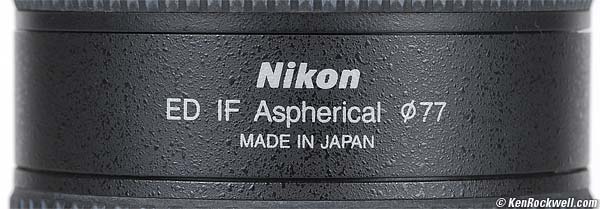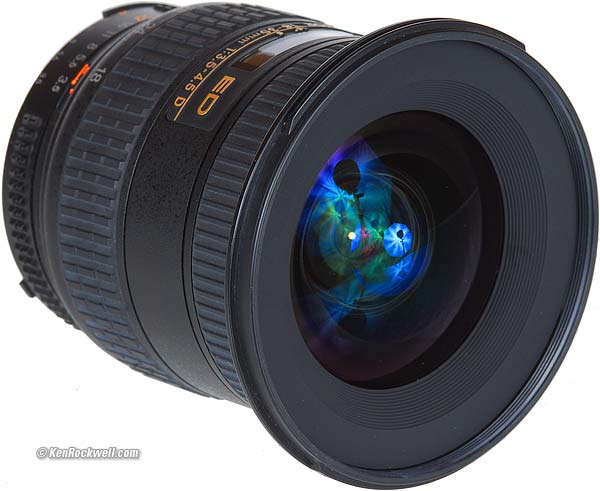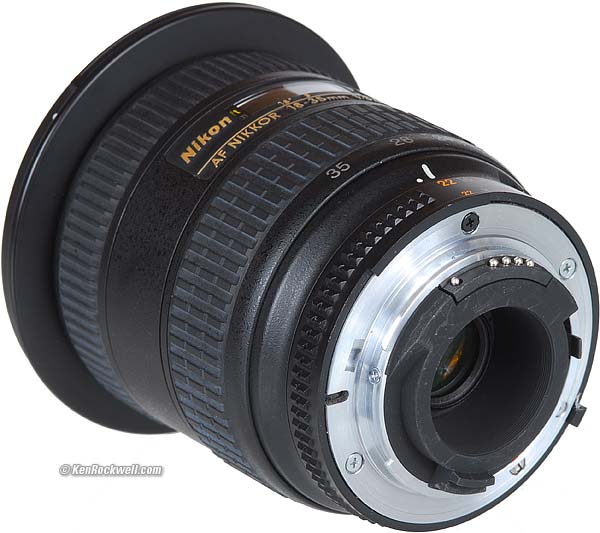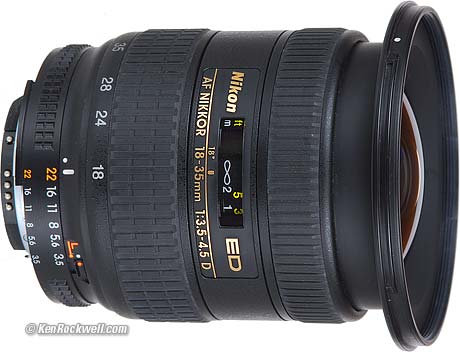Home Donate New Search Gallery Reviews How-To Books Links Workshops About Contact
Nikon
18-35mm AF-D
FX, 35mm and DX, $600 (2000-)
©
2013 KenRockwell.com
Intro Specs Performance Compared Recommendations
Nikon 18-35mm f/3.5-4.5 AF-D (77mm filters, 13.1 oz/370g, about $600 new or $325 used). enlarge. This free website's biggest source of support is when you use these links, especially this link to it at Adorama, at Amazon, at B&H Photo-Video, or get it used at this link to them at eBay (see How to Win at eBay), when you get anything, regardless of the country in which you live. Thanks! Ken.
January 2013 More Nikon Reviews Nikon Lenses All Reviews
NEW: Nikon 18-35mm f/3.5-4.5 G.
Introduction top
Intro Specs Performance Compared Recommendations
The Nikon 18-35mm is Nikon's lightest-weight ultrawide zoom. It covers film and FX, and is also Nikon's least expensive ultrawide zoom
This 18-35mm pretty much does the same thing as the 17-35mm f/2.8 AF-S, in plastic with more distortion, but with slightly better sharpness, for a lot less money.
The newest $1,800 14-24mm f/2.8 AF-S is far superior optically to any other ultrawide zoom ever made, period. If we forget that for the rest of this review, this plastic 18-35mm is actually a little bit sharper on my D3 than the 17-35mm f/2.8 AF-S and the 20-35mm AF-D! Why? The 18-35mm is newer, slower, and has more distortion than these, too.
The 18-35mm is fun, small, lightweight, fast, easy to use and gives great results. What you lose for saving $1,000 over the 17-35mm f/2.8 AF-S is distortion and the need to move a switch for manual focus.
Compatibility
The 18-35mm works great with almost every film and digital Nikon camera made since 1977. If you have a coupling prong added to the diaphragm ring, it's perfect with every Nikon back to the original Nikon F of 1959.
The 18-35mm is an FX lens and works especially well with on FX, 35mm and DX Nikons like the D7000, D700, D3X, D300s and F6. It works fantastically on manual-focus cameras like the F2AS, F3, FE and FA, since it has real manual-focus and aperture rings that work exactly as they should.
The only incompatibility is that it will not autofocus with the cheapest D40, D40x, D60, D3000, D3100, D5000 or D5100, but if you focus manually, everything else works great. These cameras have in-finder focus confirmation dots to help you.
See Nikon Lens Compatibility for details on your camera. Read down the "AF, AF-D (screw)" column for this lens.
Specifications top
Intro Specs Performance Compared Recommendations
Name
Nikon calls this the Nikon AF Zoom-Nikkor 18-35mm f/3.5-4.5 D ED IF Aspherical.
D: Sends focus distance information to camera for better exposure, especially with flash, than non-D AF lenses from the 1986-1993 era .
ED: Magic glass for sharper images.
IF: Internal Focusing: it focuses and zooms by moving the internal elements.
Aspherical: Specially curved lens element which allows higher performance.

Underside, Nikon 18-35mm.
Nikon has so much alphabet soup on the 18-35mm that they have to continue it on the back!
Optics
11 elements in 8 groups.
It uses one compound aspherical lens element and one element of magic ED glass. A compound aspherical is gluing a thin plastic corrective sheet over a glass element, and allows Nikon to get performance in this lens that used to cost thousands of dollars with traditionally hand-ground aspherical elements.
Diaphragm
Seven rounded blades, stopping down to f/22.
Filter Size
77mm, the professional standard and the same as the 17-35mm AF-S and 12-24mm DX.
AF System
It uses the old-style mechanical AF linkage, so it won't autofocus on the cheapest digital cameras. Even on those cheap cameras, everything else works great, including an electronic manual focus indicator. (see Lens Compatibility and read down the AF and AF-D column)
Close Focus
13" or 0.33m from the film plane, which is way too close for safety if you shoot airplane propellers.
Size
3.258" extension from flange x 3.254" diameter (82.76 x 82.64mm) when set to 28mm.
The 18-35mm gets slightly longer at the 35mm setting and grows to a maximum of 3.590" (91.17mm) when set to the 18mm setting.
Focus is internal, so nothing moves as focussed.
Nikon specifies 3.2" (81mm) around and 3.2" (81mm) long.
Weight
13.055 oz. (370.1 g), as measured by me.
Nikon specifies 13.1 oz (370g).
Hood
HB-23 plastic bayonet hood, included. It's the same hood included with the 17-35mm AF-S and 12-24mm DX.
Case
CL-S2 soft pouch, optional.
Quality
Made in Japan.
Introduced
Summer 2000.
Production
Nikon has made just over 100,000 of these as of 2011.
Price, USA
$605, January 2013.
$600, July 2011.
$600, 2010.
$490, 2000-2007.

Nikon 18-35mm f/3.5-4.5 AF-D.
Performance top
Intro Specs Performance Compared Recommendations
This is a fast, fun little lightweight lens that gives sharp pictures.
It's not the best if you're planning on looking at the corners with a microscope (for that get the $1,800 14-24mm), but for film and even for the D3, sure, get one if you're tempted.
Overall sharpness is about the same as the 17-35mm and 20-35mm, but nothing compared to the newest 14-24mm if you're looking closely.
Autofocus
AF is just about instantaneous on an F100 and D3. One full turn of the AF screw focuses it from infinity to 1.9 feet. That's fast!
On a 12 MP FX Digital Camera:
Falloff (darker corners)
18mm: Moderate falloff wide open, gone for most uses at f/5.6, completely gone by f/8.
24mm: Minor falloff at f/4, gone by f/5.6.
28mm: Minor falloff at f/4.2, gone by f/5.6.
35mm: Minor falloff at f/4.5, gone by f/5.6.
Sharpness
At 18mm: Very sharp in center at all apertures. Soft in corners t f/3.5, but still better than 20-35mm f/2.8. Better at f/5.6, but never gets perfect even stopped down to f/16.
At 24mm: Sharp in center at f/4, perfect by f/5.6. Corners sharp but hazy at f/4, a little better at f/5.6, best at f/11 and f/16.
At 28mm: Sharp in center at f/4.2, perfect by f/5.6. Hazy but sharp in corners wide open, best at f/16.
At 35mm: Sharp in center at f/4.5, perfect by f/5.6. Sharp but hazy in corners at f/4.5, best f/8 - f/22.
On Fuji Velvia 50:
The Nikon 18-35mm gives snappy, contrasty and sharp images at all focal lengths even wide open. It is a little soft in the corners at all focal lengths wide open, but still better than my fixed manual focus lenses. It sharpens up and gives fantastic results stopped down a couple of stops. Actually, this is better than any lens other then the 17-35mm and 14-24mm which are at least three times as expensive. The plastic 18-35mm is much nicer than you think. Here are the specifics:
at 18mm:
f/3.5: very sharp all over except for the last couple of mm of the field. Very little falloff of illumination.
f/5.6: very sharp all over except for the last two mm of the far corners. No falloff.
f/8: very sharp all over except the far corners. No falloff.
f/11: very sharp all over except for the last two mm of the far corners with these corners a bit better than f/8 or f/5.6. No falloff.
at 25mm:
f/4: very sharp all over except for the last several mm of the field. Very little falloff of illumination.
f/5.6: very sharp all over except for the last two mm of the far corners. No falloff.
f/8: very sharp all over except for the last two mm of the far corners. No falloff.
f/11: very sharp all over except for the last two mm of the far corners. No falloff.
at 35mm:
f/4.5: very sharp all over except for the last several mm of the field. Very little falloff of illumination.
f/5.6: very sharp all over except the far corners. No falloff.
f/8: very sharp all over except the far corners. No falloff.
f/11: very sharp all over except the far corners. No falloff.
Construction and Mechanics

Nikon 18-35mm f/3.5-4.5 AF-D.
Barrel: Plastic.
Zoom and Focus Rings: Plastic.
Filter thread and bayonet hood mount: Plastic.
Name Plate: Embossed Metal.
Barrel and aperture ring markings: Paint.
Serial number: Laser-burnt into bottom of aperture ring.
Mount: Chromed brass.
Black screw on mount to help when mounting on camera? Yes.
Distortion
It has a lot of complex barrel distortion. Skip the 18-35mm if you want to shoot architecture or seascapes with horizon lines at the top or bottom of your image. The distortion has a complex signature, so it's difficult to remove except with tools more specialized than Photohop's default lens correction tool.
Don't worry about it if you want a compact, lightweight, fast handling lens for images in which straight lines that run along the edges are unimportant.
Remember that if you want to shoot a lot of serious architecture or landscapes then you shouldn't be diddling around with Nikon or Canon or Leica or any 35mm camera anyway; you really should be shooting with a 4x5" instead.
It has moderate barrel distortion at 35mm. It only gets worse from there. It's really bad at 18mm, with a complex signature that would be very difficult to remove in Photoshop. Unlike most zooms, there is no focal length at which you can get good rectilinear performance. For instance, you can set the 17-35mm f/2.8 AF-S to 23mm at which point all distortion is gone. If you need straight lines stay at the 35mm setting and pray.
Plug these figures into Photoshop CS2's lens distortion filter to correct the distortion. These aren't facts or specifications, they are the results of my research.
3' (1m) FX |
10' (3m) FX |
15' (5m) FX |
3 ' (1m) DX |
|
18mm |
+3.0** |
+2.0** |
+2.0** |
+4.5 |
24mm |
+3.2* |
+2.5* |
+2.0* |
+3.0 |
28mm |
+3.0 |
+2.0 |
+2.0 |
+2.0 |
35mm |
+2.0 |
+1.2 |
+1.0 |
+1.0 |
© 2007 KenRockwell.com
* wavy; never completely corrects with this tool.
** very wavy; never completely corrects with this tool.
Flare and Ghosts
Flare and ghosting are great; I see little to no problem shot straight into the sun.
Maximum Aperture
18mm |
f/3.5 |
24mm |
f/4 |
28mm |
f/4.2 |
35mm |
f/4.5 |
Use with Filters top
The filter ring never rotates. It moves in and out with zooming, and nothing moves when focused.
It's great for using polarizing and split filters since they stay put as you manipulate the lens. Of course you'll want to go easy with polarizers on a wide angle, since the polarization of the sky varies over such a large angle and gives uneven results.
No problem! Even on full-frame, my conventional rotating polarizer or rotating screw-in graduated ND (each 7mm thick excluding threads) work without any vignetting at every aperture and focal length.
There sometimes can be just a little vignetting on FX digital with a fat filter at 18mm; be careful and try yours first. This is with 7mm thick rotating filters; any standard non-rotating filter is thinner and never a problem.
If you focus very close at 18mm with a conventional thick rotating filter, there will be vignetting on an FX camera. It's more obvious at smaller apertures. This isn't a problem at normal focus distances.
If you want to use two of these stacked (14mm thick excluding threads), it works great, but only from 21-35mm. There's serious vignetting with two stacked fat filters at 18mm on film and FX Digital, but what do you expect? It's still no problem on DX digital.
Focal Length Encoding Accuracy
I see 18mm, 24mm, 28mm ad 35mm correlating between EXIF and the setting on the zoom ring.
Instruction Sheet
The instructions erroneously mention a 9-bladed diaphragm. My lens only has seven blades, standard for Nikon.
Compared top
Intro Specs Performance Compared Recommendations
See Nikon Ultrawide Zooms Compared.
See Sharpness Comparison to all other 24mm lenses August 2010
See Compared to the Tokina 20-35mm f/3.5-4.5 AF November 2010
Recommendations top
Intro Specs Performance Compared Recommendations
If you think you want one, get one.
This is an FX lens for film or FX digital cameras. It is silly to use it on a smaller DX digital camera because the 18-55mm DX works better and costs one-fifth as much.
This is a fun little lens and it makes great sharp images far better than it has any right to. Unless you have a spare extra $1,000 in your pocket or need low distortion then this is the clear winner. Don't even consider the stuff from Sigma or Tamron; this lens is spectacular. Even for the same or less price and even if you can get an f/2.8 from the off-bands stick with this winner. This is a great lens for many purposes, and looks and feels nice, too.
If linear distortion bothers you skip it and get a 4x5 camera instead, or the AF 20-35mm f/2.8.
For a the same money you could get the fixed focal length AF 20mm f/2.8. The 20mm AF will be smaller, faster, lighter, and have less distortion, but lose the ability to zoom. Personally I'd get this 18-35mm for the convenience.
For a little more money you can get a used, older professional AF 20-35mm f/2.8. zoom. This old pro zoom is built like a tank (duh), but it's not as sharp and doesn't go quite as wide. It sure feels good, though!
For three times as much money you could get the pig-sized 17-35mm f/2.8 AF-S lens. The only advantages to the 17-35 are durability, ease of manual focusing and distortion. Otherwise this 18-35 gives exactly the same sharp results with a little more distortion. The 18-35mm excels in size, weight and price over the 17-35.
Overall, if I were on a budget (money or weight) this would be one of only two lenses I'd take with me.
Help me help you top
I support my growing family through this website, as crazy as it might seem.
The biggest help is when you use any of these links when you get anything, regardless of the country in which you live. It costs you nothing, and is this site's, and thus my family's, biggest source of support. These places have the best prices and service, which is why I've used them since before this website existed. I recommend them all personally.
If you find this page as helpful as a book you might have had to buy or a workshop you may have had to take, feel free to help me continue helping everyone.
If you've gotten your gear through one of my links or helped otherwise, you're family. It's great people like you who allow me to keep adding to this site full-time. Thanks!
If you haven't helped yet, please do, and consider helping me with a gift of $5.00.
As this page is copyrighted and formally registered, it is unlawful to make copies, especially in the form of printouts for personal use. If you wish to make a printout for personal use, you are granted one-time permission only if you PayPal me $5.00 per printout or part thereof. Thank you!
Thanks for reading!
Mr. & Mrs. Ken Rockwell, Ryan and Katie.
Home Donate New Search Gallery Reviews How-To Books Links Workshops About Contact



